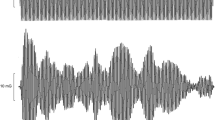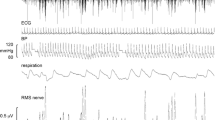Abstract
Using low-frequency (0.08–0.18 Hz) sinusoidal galvanic vestibular stimulation (sGVS), we recently showed that two peaks of modulation of muscle sympathetic nerve activity (MSNA) and skin sympathetic nerve activity (SSNA) occurred for each cycle of stimulation: a large peak associated with the positive peak of the sinusoid (defined as the primary peak) and a smaller peak (defined as the secondary peak) related to the negative peak of the sinusoid. However, these recordings were only made from the left common peroneal nerve, so to investigate lateralisation of vestibulosympathetic reflexes, concurrent recordings were made from both sides of the body. Tungsten microelectrodes were inserted into muscle or cutaneous fascicles of the left and right common peroneal nerves in 17 healthy individuals. Bipolar binaural sinusoidal GVS (±2 mA, 100 cycles) was applied to the mastoid processes at 0.08 Hz. Cross-correlation analysis revealed that vestibular modulation of MSNA (10 bilateral recordings) and SSNA (6 bilateral recordings) on the left side was expressed as a primary peak related to the positive phase of the sinusoid and a secondary peak related to the negative phase of the sinusoid. Conversely, on the right side, the primary and secondary peaks were reversed: the secondary peak on the right coincided with the primary peak on the left and vice versa. Moreover, differences in pattern of outflow were apparent across sides. We believe the results support the conclusion that the left and right vestibular nuclei send both an ipsilateral and contralateral projection to the left and right medullary output nuclei from which MSNA and SSNA originate. This causes a “flip-flop” patterning between the two sympathetic outflows: when vestibular modulation of a burst is high on the left, it is low on the right, and when modulation is low on the left, it is high on the right.







Similar content being viewed by others
References
Aoki M, Sakaida Y, Tanaka K, Mizuta K, Ito Y (2012) Evidence for vestibular dysfunction in orthostatic hypotension. Exp Brain Res 217:251–259
Bent LR, Bolton PS, Macefield VG (2006) Modulation of muscle sympathetic bursts by sinusoidal galvanic vestibular stimulation in human subjects. Exp Brain Res 174:701–711
Bini G, Hagbarth KE, Hynninen P, Wallin BG (1980) Regional similarities and differences in thermoregulatory vaso- and sudomotor tone. J Physiol 306:553–565
Bolton PS, Wardman DL, Macefield VG (2004) Absence of short-term vestibular modulation of muscle sympathetic outflow, assessed by brief galvanic vestibular stimulation in human subjects. Exp Brain Res 154:39–43
Carter JR, Ray CA (2008) Sympathetic responses to vestibular activation in humans. Am J Physiol Regul Integr Comp Physiol 294:R681–R688
Cui J, Mukai C, Iwase S, Sawasaki N, Kitazawa H, Mano T, Sugiyama Y, Wada Y (1997) Response to vestibular stimulation of sympathetic outflow to muscle in humans. J Auton Nerv Syst 66:154–162
Cui J, Iwase S, Mano T, Katayama N, Mori S (1999) Muscle sympathetic nerve response to vestibular stimulation by sinusoidal linear acceleration in humans. Neurosci Lett 267:181–184
Cui J, Iwase S, Mano T, Katayama N, Mori S (2001) Muscle sympathetic outflow during horizontal linear acceleration in humans. Am J Physiol 281:R625–R634
Dampney RA, Horiuchi J, Tagawa T, Fontes MA, Potts PD, Polson JW (2003) Medullary and supramedullary mechanisms regulating sympathetic vasomotor tone. Acta Physiol Scand 177:209–218
Delius W, Hagbarth KE, Hongell A, Wallin BG (1972) Manoeuvres affecting sympathetic outflow in human skin nerves. Acta Physiol Scand 84:177–186
Diedrich A, Porta A, Barbic F, Brychta RJ, Bonizzi P, Diedrich L, Cerutti S, Robertson D, Furlan R (2009) Lateralization of expression of neural sympathetic activity to the vessels and effects of carotid baroreceptor stimulation. Am J Physiol Heart Circ Physiol 296:H1758–H1765
Doba N, Reis DJ (1974) Role of the cerebellum and the vestibular apparatus in regulation of orthostatic reflexes in cats. Circ Res 40:9–18
Fitzpatrick RC, Day BL (2004) Probing the human vestibular system with galvanic stimulation. J Appl Physiol 96:2301–2316
Goldberg JM, Smith CE, Fernandez C (1984) Relation between discharge regularity and responses to externally applied galvanic currents in vestibular nerve afferents of the squirrel monkey. J Neurophysiol 51:1236–1256
Grewal T, James C, Macefield VG (2009) Frequency-dependent modulation of muscle sympathetic nerve activity by sinusoidal galvanic vestibular stimulation in human subjects. Exp Brain Res 197:379–386
Grewal T, Dawood T, Hammam E, Kwok K, Macefield VG (2012) Low-frequency physiological activation of the vestibular utricle causes biphasic modulation of skin sympathetic nerve activity in humans. Exp Brain Res 220:101–108
Hammam E, James C, Dawood T, Macefield VG (2011) Low-frequency sinusoidal galvanic stimulation of the left and right vestibular nerves reveals two peaks of modulation in muscle sympathetic nerve activity. Exp Brain Res 213:507–514
Hammam E, Dawood T, Macefield VG (2012) Low-frequency galvanic vestibular stimulation evokes two peaks of modulation in skin sympathetic nerve activity. Exp Brain Res 219:441–446
Holstein GR, Friedrich VL Jr, Martinelli GP, Ogorodnikov D, Yakushin SB, Cohen B (2012) Fos expression in neurons of the rat vestibulo-autonomic pathway activated by sinusoidal galvanic vestibular stimulation. Front Neurol 3:4
Hume KM, Ray CA (1999) Sympathetic responses to head-down rotations in humans. J Appl Physiol 86:1971–1976
James C, Macefield VG (2010) Competitive interactions between vestibular and cardiac rhythms in the modulation of muscle sympathetic nerve activity. Autonom Neurosci 158:127–131
James C, Stathis A, Macefield VG (2010) Vestibular and pulse-related modulation of skin sympathetic nerve activity during sinusoidal galvanic vestibular stimulation in human subjects. Exp Brain Res 202:291–298
Jian BJ, Cotter LA, Emanuel BA, Cass SP, Yates BJ (1999) Effects of bilateral vestibular lesions on orthostatic intolerance in awake cats. J Appl Physiol 86:1552–1560
Kaufmann H, Biaggioni I, Voustianiouk A, Diedrich A, Costa F, Clarke R, Gizzi M, Raphan T, Cohen B (2002) Vestibular control of sympathetic activity. An otolith-sympathetic reflex in humans. Exp Brain Res 143:463–469
Macefield VG, Wallin BG (1995) Effects of static lung inflation on sympathetic activity in human muscle nerves at rest and during asphyxia. J Autonom Nerv Sys 53:148–156
Macefield VG, Wallin BG (1999) Respiratory and cardiac modulation of single vasoconstrictor and sudomotor neurones to human skin. J Physiol 516:303–314
McCall AA, Yates BJ (2011) Compensation following bilateral vestibular damage. Front Neurol 2:88
Minor LB, Goldberg JM (1991) Vestibular-nerve inputs to the vestibulo-ocular reflex: a functional ablation study in the squirrel monkey. J Neurosci 11:1636–1648
Shortt Tl, Ray CA (1997) Sympathetic and vascular responses to head-down neck flexion in humans. Am J Physiol 272:H1780–H1784
Sundlof G, Wallin BG (1977) The variability of muscle nerve sympathetic activity in resting recumbent man. J Physiol 272:383–397
Sverrisdottir YB, Rundqvist B, Elam M (1998) Relative burst amplitude in human muscle sympathetic nerve activity: a sensitive indicator of altered sympathetic traffic. Clin Auton Res 8:95–100
Voustianiouk A, Kaufmann H, Diedrich A, Raphan T, Biaggioni I, Macdougall H, Ogorodnikov D, Cohen B (2006) Electrical activation of the human vestibulo-sympathetic reflex. Exp Brain Res 171:251–261
Wardman DL, Fitzpatrick RC (2002) What does galvanic vestibular stimulation stimulate? Adv Exp Biol Med 508:119–128
Yates BJ, Yamagata Y, Bolton PS (1991) The ventrolateral medulla of the cat mediates vestibulosympathetic reflexes. Brain Res 552:265–272
Yates BJ, Goto T, Bolton PS (1993) Responses of neurons in the rostral ventrolateral medulla of the cat to natural vestibular stimulation. Brain Res 601:255–264
Author information
Authors and Affiliations
Corresponding author
Rights and permissions
About this article
Cite this article
El Sayed, K., Dawood, T., Hammam, E. et al. Evidence from bilateral recordings of sympathetic nerve activity for lateralisation of vestibular contributions to cardiovascular control. Exp Brain Res 221, 427–436 (2012). https://doi.org/10.1007/s00221-012-3185-6
Received:
Accepted:
Published:
Issue Date:
DOI: https://doi.org/10.1007/s00221-012-3185-6




